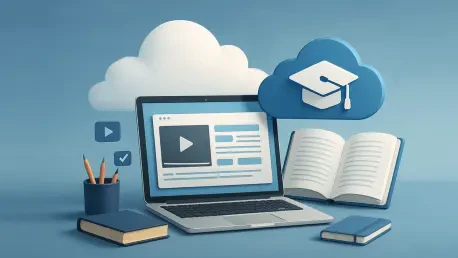Imagine a world where the boundaries of traditional education are shattered, where students and educators are no longer tied to physical classrooms or outdated systems, and where learning can happen at any moment, in any place, with just the tap of a screen. Cloud-based Learning Management Systems (LMS) are turning this vision into a tangible reality, fundamentally transforming the way educational content is delivered and managed across academic institutions and corporate environments. These innovative, internet-hosted platforms provide a flexible and powerful alternative to conventional, locally installed systems by storing resources on remote servers, making them accessible to users worldwide with an internet connection. This shift not only enhances the reach of education but also adapts it to the demands of a fast-paced, digital era. As technology continues to evolve, these platforms stand at the forefront of a movement that prioritizes accessibility, efficiency, and scalability, promising to reshape how knowledge is shared and acquired on a global scale.
Breaking Down Barriers with Accessibility
The defining strength of cloud-based LMS platforms lies in their ability to make education accessible to anyone, anywhere, as long as an internet connection is available. This feature dismantles the limitations imposed by physical locations, allowing students to engage with course materials from a laptop at home, a tablet on a bus, or a smartphone during a break. Such flexibility caters to diverse lifestyles, supporting late-night study sessions for students with packed schedules or enabling professionals to upskill without stepping into a traditional classroom. This accessibility fosters a sense of autonomy, empowering learners to take control of their educational journey at a pace that suits their individual needs. Beyond convenience, it also bridges geographical gaps, connecting rural or remote learners to the same high-quality resources as their urban counterparts, thus leveling the playing field in a way that traditional systems often fail to achieve.
Moreover, the impact of this accessibility extends to educators who can now reach a broader audience without being confined to a single location. Teachers can upload lectures, assignments, and feedback from any device, ensuring that learning continues even outside regular hours or during unexpected disruptions like natural disasters or pandemics. This capability has proven vital in maintaining educational continuity, allowing institutions to pivot swiftly to remote learning when needed. For global organizations, it means training programs can be rolled out uniformly across different regions, ensuring consistency in content delivery. The democratization of access that cloud-based LMS platforms provide is not just a technological advancement but a social equalizer, opening doors for underserved communities and fostering inclusivity in education on an unprecedented scale.
Enhancing Efficiency Through Scalability
Cloud-based LMS platforms are revolutionizing education by streamlining processes with remarkable efficiency, particularly for educators tasked with managing complex administrative duties. These systems offer intuitive tools that simplify the creation and organization of courses, as well as the tracking of student progress, saving countless hours that would otherwise be spent on manual tasks. Features like automated grading and real-time performance monitoring allow teachers to focus on delivering personalized instruction rather than getting bogged down by repetitive paperwork. This shift not only boosts productivity but also enhances the quality of education by enabling more meaningful interactions between educators and learners. The ease of updating content in real time further ensures that materials remain relevant, adapting quickly to new information or curriculum changes without the delays associated with traditional systems.
Another critical advantage is the scalability these platforms offer to educational institutions and businesses alike. Unlike conventional server-based setups that require significant investments in hardware to accommodate growth, cloud-based systems can expand effortlessly with user demand. This means a school can start with a small user base and scale up as enrollment increases, without incurring prohibitive costs for additional infrastructure. For corporations, it allows training programs to grow alongside workforce expansion, ensuring that learning resources keep pace with organizational needs. This adaptability is particularly beneficial in dynamic environments where flexibility is key to staying competitive. By eliminating the financial and logistical barriers to growth, cloud-based LMS platforms empower organizations to focus on their core mission of education and development rather than being constrained by technical limitations.
Affordability as a Game-Changer
One of the most compelling benefits of cloud-based LMS platforms is their cost-effectiveness, which makes advanced educational tools accessible to a wider range of institutions and organizations. By removing the need for expensive physical infrastructure, such as on-site servers and dedicated IT facilities, these systems significantly lower upfront costs. Instead, subscription-based pricing models offer financial flexibility, allowing schools and businesses to pay only for what they use, often on a monthly or annual basis. This approach contrasts sharply with the hefty capital investments required for traditional systems, making it feasible for smaller or underfunded entities to adopt cutting-edge technology without straining their budgets. The result is a democratization of quality educational resources that can reach even the most resource-constrained settings.
Additionally, the financial benefits extend beyond initial costs to include reduced maintenance expenses. Cloud service providers handle updates, security patches, and technical support, eliminating the need for in-house IT teams to manage these tasks. This not only cuts operational costs but also frees up institutional resources to focus on core educational goals rather than technical upkeep. For many organizations, this shift represents a strategic advantage, enabling them to allocate funds toward improving teaching quality or expanding program offerings. The affordability of cloud-based LMS platforms thus serves as a catalyst for innovation, allowing diverse educational entities to experiment with new teaching methods and technologies that were previously out of reach due to financial constraints, ultimately benefiting learners across various contexts.
Building Trust with Security and Collaboration
Security stands as a cornerstone of cloud-based LMS platforms, addressing concerns about data privacy and service reliability in an increasingly digital educational landscape. Reputable providers implement robust measures such as data encryption, regular security audits, and redundant backups to safeguard sensitive information like student records and institutional data. These precautions ensure minimal downtime and protect against data loss, fostering trust among users who rely on these systems for critical learning activities. High uptime guarantees and quick technical support further enhance reliability, ensuring that disruptions to the learning process are kept to a minimum. This focus on security reassures institutions that transitioning to cloud-based solutions does not mean compromising on the safety of their digital assets, a vital consideration in today’s cyber-threat environment.
Equally important is the capacity of these platforms to integrate seamlessly with other digital tools, creating a collaborative and interactive learning ecosystem. Compatibility with video conferencing software, content creation applications, and group collaboration tools enables dynamic educational experiences, from live lectures to peer discussions and joint projects. This interoperability transforms static learning into an engaging process, where students can interact in real time with instructors and peers, regardless of physical distance. Such connectivity not only enriches the educational experience but also prepares learners for modern workplaces that increasingly rely on digital collaboration. By combining strong security with powerful integration capabilities, cloud-based LMS platforms offer a comprehensive solution that supports both the safety and the interactive needs of contemporary education, paving the way for more connected and protected learning environments.
Addressing Hurdles for Wider Adoption
Despite the transformative potential of cloud-based LMS platforms, certain challenges must be navigated to ensure their benefits reach all intended users. A primary obstacle is the dependence on stable internet connectivity, which remains a significant barrier in regions with underdeveloped infrastructure. In rural or underserved areas, inconsistent access to high-speed internet can exclude students and educators from engaging with these platforms, exacerbating existing digital divides. This disparity highlights the urgent need for investments in broadband expansion and alternative connectivity solutions to make cloud-based learning truly inclusive. Addressing this issue is not just a technological imperative but a social one, as equitable access to education remains a cornerstone of global development goals that technology must support rather than hinder.
Another critical challenge lies in the learning curve associated with adopting these advanced systems, which often requires comprehensive training for both educators and students. Without proper guidance, users may struggle to navigate the full range of features, from content management to analytics tools, thereby underutilizing the platform’s capabilities. Institutions must therefore prioritize professional development programs and ongoing support to build digital literacy among their communities. This investment in training is essential to maximize the return on adopting cloud-based LMS platforms, ensuring that users can confidently leverage the technology to enhance learning outcomes. By proactively tackling connectivity and skill gaps, stakeholders can pave the way for broader acceptance and more effective implementation of these systems, ultimately bridging the divide between potential and practical impact in diverse educational settings.
Paving the Way Forward with Strategic Solutions
Reflecting on the journey of cloud-based LMS platforms, it’s evident that their adoption marked a turning point in how education is delivered and managed across varied landscapes. Their ability to provide accessible, efficient, and affordable learning solutions reshaped expectations, setting a new standard for what educational technology could achieve. Security measures and integration capabilities further solidified their role as trusted tools that adapted to the needs of a digital age, even as they navigated complex challenges. The strides made in overcoming initial skepticism demonstrated a collective commitment to innovation, driven by a shared vision of making education more inclusive and dynamic through technological advancement.
Looking ahead, the focus must shift to actionable strategies that address lingering barriers and amplify the impact of these platforms. Investments in global internet infrastructure should be prioritized to ensure no learner is left behind due to connectivity issues, while partnerships between governments, tech providers, and educational bodies could accelerate progress in this area. Simultaneously, tailored training initiatives must be scaled to equip users with the skills needed to fully harness these systems, turning potential hurdles into opportunities for growth. By fostering collaboration and innovation, the educational community can build on past successes, ensuring that cloud-based LMS platforms continue to evolve as indispensable tools that empower learners and educators in an ever-changing world.









